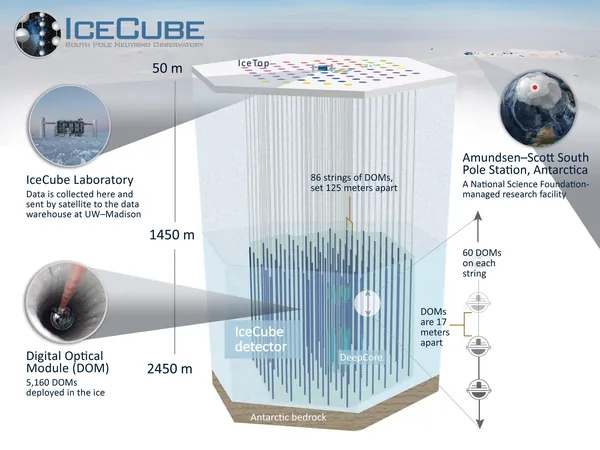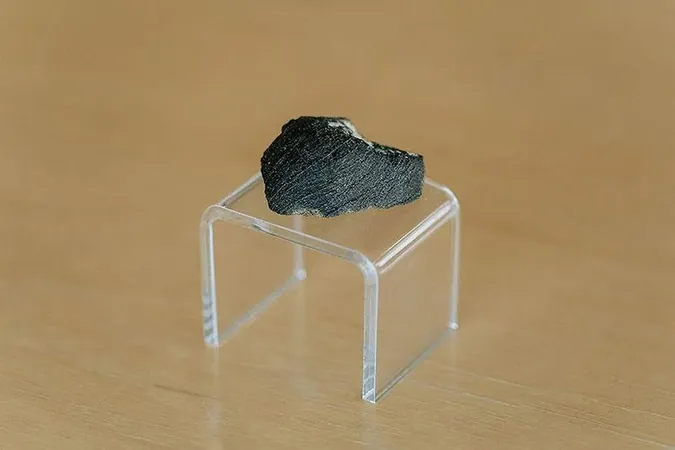
IceCube Experiment Dashes Hopes for Existence of Mysterious Sterile Neutrinos
2024-11-25
Author: Rajesh
For decades, particle physicists have been on a quest to find elusive "sterile neutrinos," hypothetical particles that could transform our understanding of the universe. Unlike the three known neutrinos—the electron, muon, and tau neutrinos—that interact through the weak force and, to some extent, gravitational force, sterile neutrinos would be completely non-interacting under the Standard Model of particle physics, potentially offering resolutions to several neutrino-related anomalies and contributing to theories about dark matter.
However, the search for these enigmatic particles has been hindered by a lack of experimental evidence. The IceCube Collaboration, a groundbreaking neutrino observatory located deep within the Antarctic ice, has recently completed a substantial analysis that further lowers the odds of sterile neutrinos existing. Utilizing an impressive 10.7 years of data collected near the Amundsen-Scott South Pole Station, the collaboration's latest paper published in *Physical Review Letters* reveals a probability of just 3.1% that sterile neutrinos could exist.
Alfonso García Soto, a researcher from the Instituto de Física Corpuscular (IFIC) in Spain and a lead contributor to the analysis, stated, “With IceCube, we have made significant advancements in the search for a fourth type of neutrino. Thanks to enhanced data models and artificial intelligence, we have refined our search methods.”
Neutrinos are already known to be some of the most mysterious particles, oscillating between different types as they travel and exhibiting astonishingly small mass. While the three recognized flavors are confirmed to exist, their individual masses remain uncertain, leading physicists to speculate about additional particles that could complement the currently accepted framework of particle physics.
IceCube stands out as the largest neutrino observatory globally, with its cubic kilometer of sensors embedded deep in the Antarctic ice. These sensors detect neutrinos produced by cosmic ray collisions in the atmosphere, registering brief flashes of light when neutrinos interact with the ice. The observatory’s innovative design allows it to filter out unwanted background signals, particularly from atmospheric muons that can mimic neutrino interactions.
Despite the extensive research efforts—IceCube has consistently reported negative findings regarding sterile neutrinos over the years—other experimental setups, like MicroBoone, have also yielded similar results. Earlier in 2023, IceCube's investigation using 7.5 years of data from its inner detector core, DeepCore, found no evidence of sterile neutrinos, reinforcing the theory that these particles do not mix with the active flavors.
The comprehensive results from IceCube are bolstered by significant improvements in their methodologies, expanding the energy range for muon neutrinos analyzed from 10 TeV to 100 TeV, and refining the models constructed for neutrino flux and detector interactions.
Ignacio Taboada, a spokesperson for IceCube from the Georgia Institute of Technology, highlighted that collaborative international efforts were pivotal in achieving these results. The depth of expertise involved is considerable, with 420 authors from 58 institutions across 14 different countries contributing to the latest paper.
As the search for sterile neutrinos continues without success, the implications of these findings extend beyond mere particle physics, potentially reshaping our understanding of dark matter and the fundamental forces of nature. The question remains: will sterile neutrinos ever be found, or will they remain an elusive mystery, forever just out of reach?
Stay tuned as scientists delve deeper into the cosmos, and remember, in the world of particle physics, every negative result is just another step towards a breakthrough!

 Brasil (PT)
Brasil (PT)
 Canada (EN)
Canada (EN)
 Chile (ES)
Chile (ES)
 España (ES)
España (ES)
 France (FR)
France (FR)
 Hong Kong (EN)
Hong Kong (EN)
 Italia (IT)
Italia (IT)
 日本 (JA)
日本 (JA)
 Magyarország (HU)
Magyarország (HU)
 Norge (NO)
Norge (NO)
 Polska (PL)
Polska (PL)
 Schweiz (DE)
Schweiz (DE)
 Singapore (EN)
Singapore (EN)
 Sverige (SV)
Sverige (SV)
 Suomi (FI)
Suomi (FI)
 Türkiye (TR)
Türkiye (TR)